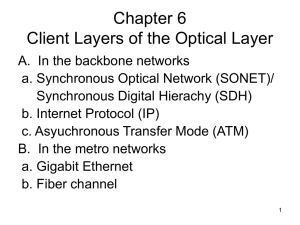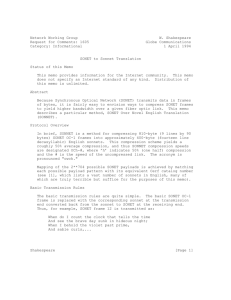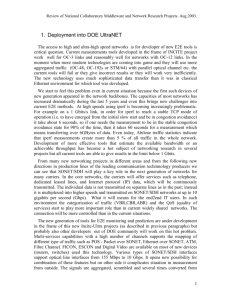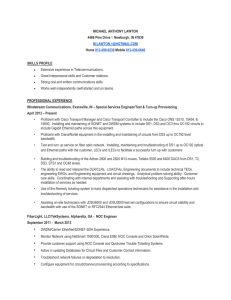4Williams_CREZ Communications Final Presentation
advertisement
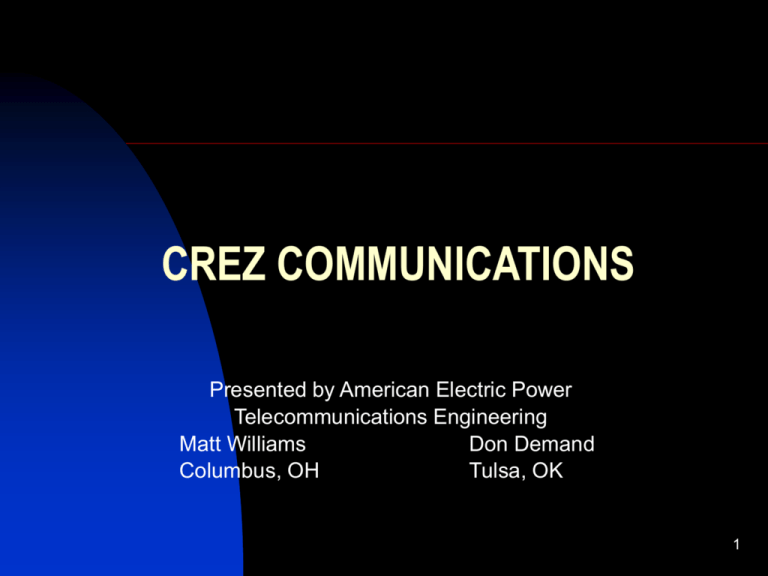
CREZ COMMUNICATIONS Presented by American Electric Power Telecommunications Engineering Matt Williams Don Demand Columbus, OH Tulsa, OK 1 AEP OPGW Network The AEP Telecom Engineering offices in Columbus, OH and Tulsa, OK are responsible for supporting a 3,000 mile fiber optic cable network covering 11 states. Approximately 920 miles of this network is comprised of Optical Ground Wire (OPGW) on various AEP 765kV, 345kV, 138kV and 69kV Transmission lines. 7 State AEP East Region Fiber Network 4 State AEP West Region Fiber Network 2 Installing OPGW for Communications Benefits 40+ year life expectancy when installed & maintained properly. Less susceptible to outages relative to other cable types such as ADSS on T-Line, Distribution poles or underground construction. Eliminates clearance and Right-Of-Way issues since it occupies the static wire position on a Transmission Line. Low installation cost on new T-Line construction. Owned fiber systems are a critical component in the mix of technologies to provide highly reliable and secure communications systems. Other systems include microwave and leased circuits. The inclusion of OPGW fiber cable on new and modified lines will continue to add route diversity as the transmission system grows. Disadvantages Repairs can require a T-Line outage to replace a damaged section which could result in an extended fiber outage. Diverse OPGW routes, the use of diverse technologies, and disaster preparedness can alleviate this operational concern. 3 Installing OPGW for Communications Cost Approximately $10K/mile incremental cost difference for new line construction or to install OPGW with a line reconductoring project. $5K is for the cost difference of OPGW versus traditional static wire and the other $5K covers the increased cost of OPGW tower hardware and the Material & Labor for fiber splicing (which assumes a splice every 3 miles). T-Line crew installation labor is assumed to be the same for OPGW as static wire. To retrofit an existing line (replace static wire with OPGW) the cost is between $50K - $70K per mile and must be coordinated with scheduled line outages. 4 Advantages of installing SONET Rings Benefits SONET multiplexers are designed to be redundant and self-healing by their integrated ring switching architecture. SONET rings installed on diversely routed fiber cables will provide complete redundancy and eliminates the concern of having a single point of failure in a communications network. Without diverse cable routing a single fiber cut can interrupt all fiber based communications on a single Transmission Line. Lower level SONET (OC-3/155Mb/s) can be extended via microwave communications and serve as a diverse route for critical locations. SONET deploys higher capacity communication networks that are scalable to accommodate bandwidth growth and reliable to support critical station to station to head end communications. OC-3 (155Mb/s) to OC-12 (622Mb/s) to OC48 (2.5Gb/s). Other station communications requirements such as SCADA, Station Data Repository, Synchrophasors, Smart-grid, video surveillance, voice and Ethernet/WAN communications as well as other regional business critical communications (mobile radio, corporate data, etc.) can all be supported and transported by SONET based networks. 5 Utility Grade SONET Multiplexers Key Features of a Utility Grade SONET Multiplexer Compliant with all ANSI/IEEE C37.90 specifications. Enhanced protection switching (<3ms) for critical applications such as P&C Teleprotection signals when compared to Carrier grade SONET equipment (<60ms). Some provide direct access to DS0 channel level in order to provide direct interface connections to relays (via C37.94 or RS-232/422), DTT XMT and RCV equipment and contact I/O devices. Most Carrier grade SONET equipment offers granularity down to the DS1 level (24 DS0 multiplexed signal). Power supplies capable of using 48VDC or 130VDC directly from the station battery (Carrier grade equipment operates at -48VDC). Windows based Network Management System (NMS) with alarm engine, remote alarming and diagnostics. Interoperability with foreign SONET equipment at the OC-3, OC-12 or OC48 levels to pass NMS information and circuits through other vendors equipment chassis. 6 Advantages of installing SONET Rings Cost The cost of a utility grade SONET multiplexer is between $20K and $25K per node. Typically one node is installed at each site but depending on the ring architecture, fiber cable topology and redundancy requirements there may be situations where more than one node is required per site (station control house). While a comparable Carrier grade SONET multiplexer may provide the same capacity at less cost - The following differences must be taken into consideration: Substation hardening requirements (ANSI C37.90 compliant) SONET Protection Switching for critical applications (3ms vs. 60ms) DC Power Plant Additional channel bank equipment to provide DS0 circuits such as 56K data, voice or other low speed drops. C37.94 optical relay interfaces and direct contact inputs for DTT. 7 Redundancy Requirement “ Transmission protection systems shall provide redundancy such that no single protection system component failure would prevent the interconnected transmission systems from meeting the system performance requirements “ - NERC Protection system shall be designed for loss of AC Current Source AC Voltage Source Protective Relay Communication Channel DC Circuitry Auxiliary Trip Relay Breaker Trip Coil Station DC Source 8 CREZ : Competitive Renewable Energy Zone r 9 SONET Ring Architecture for CREZ Network Dual high-speed relay protection scheme based on diverse OPGW routes and redundant optical fiber communication (SONET ring) system. Other side of SONET ring connected via OPGW fiber on other lines to provide a diverse path SONET MUX SONET MUX SONET MUX Self-healing SONET Ring One side of SONET ring connected over OPGW fiber on protected line SONET MUX SONET MUX C37.94 Interface between relays and SONET MUX 87L2 87L2 Relay System#2 connected to SONET ring 345kV line with OPGW 87L1 Relay System#1 connected directly over OPGW fiber on protected line 87L1 10 SONET Ring Latency 87L2 relay signal travels both directions around the SONET ring in a working/protection configuration. Propagation delay incurred in optical fiber is 8us/mile and ~26us switching & mapping delay in passing through each SONET multiplexer. 87L2 signal also travels down the other side of SONET ring (long path) 26us 480us 60 mi. SONET MUX SONET MUX 26us 26us 26us 480us 60 mi. SONET MUX 320us 40 mi. SONET MUX 3,728us Total propagation delay via long path (assume 440 mile path) 212us Total propagation delay via short path (20 miles path) 560us 70 mi. 600us 75 mi. ----------3,516us (3.516ms) Latency differential during a SONET ring switch SONET MUX 87L2 26us 26us 26us 160us 20 mi. 87L2 signal travels down one side of SONET ring (short path) SONET MUX 600us 75 mi. SONET MUX 26us 480us 60 mi. SONET MUX 87L2 11 SONET Ring Non-Relay Communications TRANS OPERATIONS CENTER OC-3 SONET RADIO OC-3 SONET RADIO Circuits can be sent in both directions around the SONET ring in a working/protection configuration. VLAN1 SCADA HEAD END VLAN2 OC-3 SONET OC-3 SONET LOCAL TOWER SITE OC-3 SONET OC-3 SONET OC-3 OC-12 SONET CORP OFFICE OC-12 SONET FIELD OFFICE VOICE VLAN2 VIDEO OC-3 SONET VOICE OC-3 SONET OC-3 SONET OC-3 SONET VLAN1 VIDEO SCADA 12 Discussion Questions? Comments? 13
